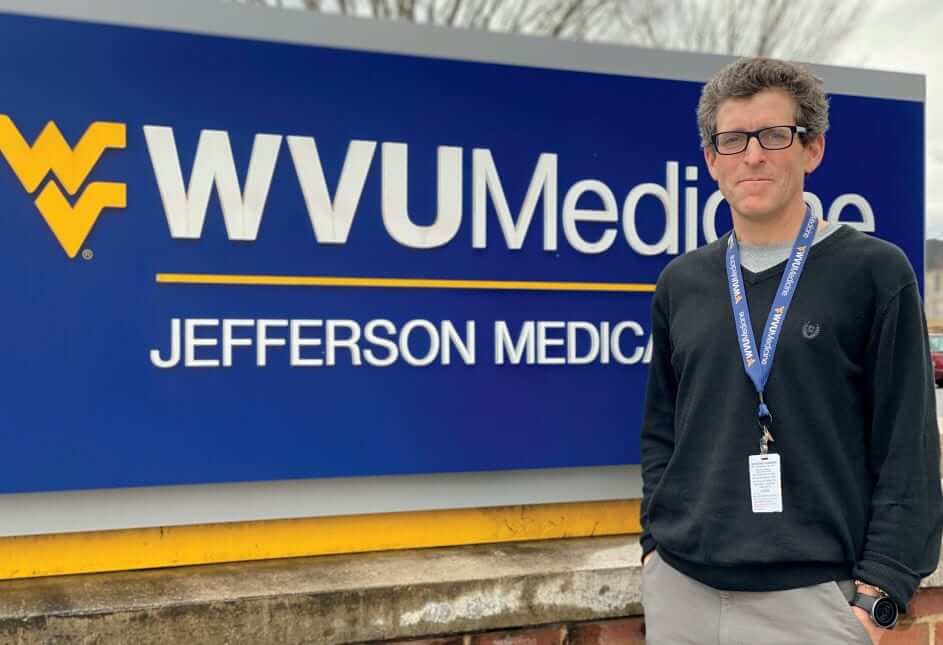After years of advocacy by Dr. Mark Cucuzzella, WVU Medicine Jefferson Medical Center removes all sugary drinks from its vending machines and cafeteria, proving that hospitals can be beacons of health.

Imagine this scenario. A patient with lung disease goes to the hospital, and the doctor says, “Smoke a cigarette, it will make you feel better.” Ridiculous, right? Now imagine this: A patient with diabetes goes to the hospital. While the patient is lying in bed, the doctor visits and lunch is served—chicken pot pie, side of rice, steamed broccoli, graham crackers, and a bottle of apple juice. The doctor is explaining to the patient the importance of controlling blood sugar levels through lowcarb food choices. The patient looks down at his tray and says, “You’re telling me that this stuff is killing me? Then why are you serving this to me?”
And this is happening all the time, all over the state. Except in one place—WVU Medicine Jefferson Medical Center—in large part thanks to Dr. Mark Cucuzzella. He is a man on a mission and, after hearing his story, you’ll agree: It is time for others to follow suit.
West Virginia has the highest rate of diabetes in adults in the nation—16 percent. In addition, more than 500,000 people in West Virginia—a staggering 36 percent of the adult population—have prediabetes, and most are not even aware. Those staggering statistics mean that nearly half of our state’s population is diabetic or pre-diabetic. And this insidious disease is striking the youngest among us at an alarming rate.
“The environment is set up to make kids sick, and it is federally subsidized,” says Cucuzzella. “If kids go to school and drink two cartons of strawberry or chocolate milk a day for free, funded by the federal government under the assumption that this is healthy, we’re basically giving them a toxin—poisoning them—in plain sight.”
The addiction to sugar starts young and, according to Cucuzzella, the only way to tackle the problem is to change our federal and state policies. “The World Health Organization, even in their position statements, which are generous on sugar because they’re assuming people are healthy, say we should have no more than six teaspoons of added sugar a day,” Cucuzzella says. “But we’re feeding kids six to seven teaspoons of added sugar in one carton of chocolate milk—and that’s just in one carton of milk. They drink two cartons a day. So 14 teaspoons of added sugar from just the milk. It’s criminal.”
Cucuzzella knows firsthand the dangers of diabetes. As a general practice physician who served in the military, he supervised a newly implemented fitness test for soldiers. He noticed that obesity was the big reason soldiers failed the test. “I realized pretty quickly, I didn’t know anything about obesity. What we learned in med school is, burn more calories than you eat. If you are fat, then you have a problem with willpower. But now we know that’s not the complete story.”
In fact, after a routine medical exam, Cucuzzella, who is a thin marathon runner, found out that his blood sugar was high. He says, “I was in the prediabetic stage—almost in a full diabetic range—and I was running marathons. Weird, right?”
After further testing and wearing a continuous glucose monitor, Cucuzzella found out that he was developing maturityonset diabetes of the young. He eliminated starchy carbs and sugar—the buckets of cereal and pasta he was eating as a runner—and found that his sugar levels were fine.
“When I came to Jefferson Medical Center, the standard hospital diet for diabetes was 60 to 80 grams of carbs per meal. And I knew just by the science of my own monitors that 10 grams of carbs raises a diabetic person’s blood sugar by about 40 points.” So with Cucuzzella’s leadership, the hospital implemented a meal option with only 10 grams of carbohydrates.
“If you give anyone who has diabetes 60 grams of carbs a meal, you are going to have to chase that with insulin, which is a rocky road,” Cucuzzella says. “The alternative is, don’t give them 60 grams of carbs. We tell our patients, ‘Here’s your option. You can eat the high-carb meal and take all the meds, or we could try this type of eating, which is actually how your grandparents ate. We’re going to give you double eggs, extra meat or fish, extra salad, and not give you insulin.”
A couple of years later, after seeing great success with the changes, a handful of lead nurses and doctors came together and decided to propose eliminating all sugary drinks from the hospital—from vending machines to soda fountains in the cafeteria to sugary protein shakes given to patients. Cucuzzella says, “It just made too much sense. It took about a year, but it’s all about teamwork and a few disruptive people. We were fortunate to have highly receptive leadership of our organization: Dean Dr. Emma Eggleston, Vice President of Operations Neil McLaughlin, and our lead nurses and dietary staff.”
Although Cucuzzella says everyone has been supportive, there were some legal hoops the hospital had to jump through. “Hospital systems that are part of universities have the same
contracts for vending as the football stadium. Coca-Cola is the exclusive provider of beverages on WVU campuses. So we had to put a clause in the contract for this institution that we could opt out of that—that it would be okay if we lost money on vending sales. But these are just some of the contractual issues you have to deal with.”
The response has been overwhelmingly positive. Patient Jack Williams was taking two pills a day along with insulin to manage his diabetes when Cucuzzella introduced him to low-carb eating. “In three weeks of eating low-carb I tossed all medications in the trash,” Williams shares. “One very helpful tool Dr. Mark recommends is a device called a ‘flash glucose monitoring system.’ This system takes away the need for having to stick your finger to get your glucose reading, so it allows you to check it as often as you like. This is helpful to set your boundaries for what you can or cannot eat, since you can see the numbers right away and at any time. People don’t realize how high sugar can affect so many things in your body, so using the monitor is a huge preventative measure to keep the body working at its optimum. Dr. Mark has shown me I can have control of my health without drugs just by using food and exercise. He saved my life.”
Judie Charlton, M.D., chief medical officer for WVU Medicine, praises Cucuzzella and his colleagues at Jefferson Medical Center. “We are proud that our Eastern WVU Medicine campus has taken the lead in initiating a sugar-free hospital. They also have taken the lead with culinary medicine and have an exceptionally strong metabolic medicine program. We are learning from their experiences with these initiatives and will share their expertise with our other campuses.”
Now, Cucuzzella is determined to eliminate sugar drinks from the school system. “If you understand obesity and diabetes, you understand the impact of just sugar-sweetened beverages—forget about the bread and the other stuff people argue about. But just the beverages. If you had to pick one thing that’s in the system, you know, poison in the system—especially for our youth—it’s the sugary beverages. Even if they eat pizza, it’s the beverages that do most harm—the sodas, the sweet tea, chocolate milk, even skim milk, and the juices people think are healthy. Juice is no different to a child’s liver than soda.”
Cucuzzella is trying to effect change on the policy level. “We’ve got to start at the hospitals and schools. The flaw in this whole thing is that we are thinking that this is some individual responsibility to prevent diabetes and obesity, when the environment is set up to make them sick. And we are doing it to our children,” Cucuzzella says. “They’ve regulated tobacco.
They regulate every addictive substance that can cause harm. Most people, including doctors, are addicted to sugar. It is a devastating drug.”
It is hard to argue with the sentiment that hospitals and schools should be beacons of health. Cucuzzella says, “In my early days at the hospital, there was a smoking room. Today, we say, ‘Can you believe we used to allow people to smoke in the hospital?’ So my dream would be, in 10 years we’ll say, ‘Can you believe we used to serve sugar in schools and hospitals? That’s freaking crazy.’”











Leave a Reply